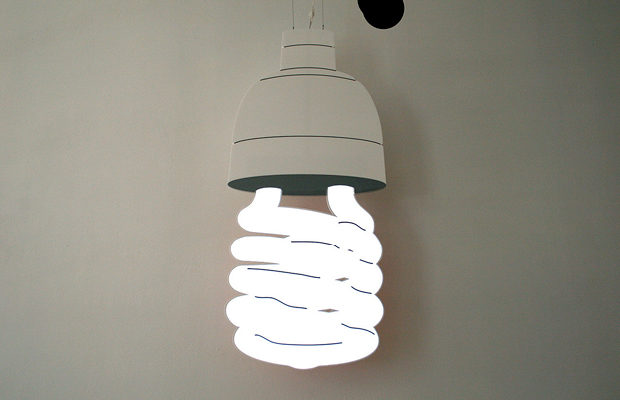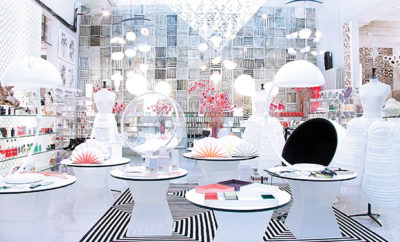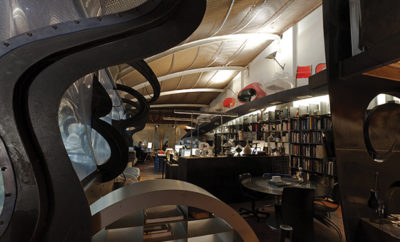 Marcus Tremonto shifts attitudes and aesthetics, often using cutting-edge technology to realize playful products. | STUDIO MARCUS TREMONTO
Marcus Tremonto shifts attitudes and aesthetics, often using cutting-edge technology to realize playful products. | STUDIO MARCUS TREMONTO
Design
Experimental, Exquisite, Exacting
FOR MARCUS TREMONTO, DESIGN COMES FROM AN INQUISITIVE MIND AND A PRECISE HAND
FOR THE 2014 SALONE DEL MOBILE IN MILAN, the New York-based lighting artist-designer Marcus Tremonto presented something that was at once contemporary, otherworldly, and strangely at home among the ornate Renaissance objects of the Museo Bagatti Valsecchi: a large transparent glass vessel decorated with a filigree of hand-cut copper, tracing— rather than flora or fauna—a pattern of steampuffing pipes, couplings, and connectors. Sprouting here and there from the surface were fine wires with LEDs encased in tiny lightbulb-shaped acrylic discs. Another network of copper pipes spread across a mat beneath the vessel and another crept around a small marble box. With the box placed on the mat— and the trio of objects united—the vessel lit up. “The idea was to create this kind of traditional vase—a Chinese vase, four hundred years old—that was a living circuit,” Marcus says of the vessel, part of the Pelle Conductivo (Conductive Skin) series.
Producing a design as exquisite as it is eccentric– a Ming vase from Super Mario World—that also ingeniously exploits the capabilities of conductivity and light would be no small feat for most designers. For Marcus, the intersection of these elements is the sweet spot. Keeping production inhouse (Marcus himself fabricates every product, with only minimal outsourcing when necessary) lets him prioritize hands-on experimentation and organic development over a signature style. His pieces shift aesthetics and attitudes, from funny to futuristic to meditative, or take on several at once, all the while exploring the possibilities of lighting technology, both primitive and high tech.
Exploration has always been Marcus’s modus operandi. He established his studio in 2002 with his wife and business partner, Monica, and while he is responsible for the designs, they’re often informed by the couple’s collaborative relationship, a dynamic that preceded the studio. “We bonded with each other because we really had the same sensibility,” Monica says. “We talk about things that we’re inspired by and ideas come from that.” From the beginning, one’s activities could motivate the other’s. “She was taking a jewelry class, making these brooches out of silver, handcutting them,” Marcus says, “and she had all these parts and cuttings to take home, and I said, can I have those? They were just interesting.” He inlaid the silver offcuts into a piece of ebony to make a tabletop and was delighted not only by the result, but the experience: “It was the first thing that I’d done in a year that made me think, I really like that I did this.”
At the time Marcus was studying painting, but was finding it unfulfilling. “I felt like everything that I loved about painting someone had already done….I was all about technique, so I found myself trying to work the craft. I’d look at a painting and think, how did he do that. Then I’d work on a detail and then make a huge painting. And I said to myself, how can I do this for the rest of my life?” By fashioning the silver and ebony tabletop, Marcus discovered that a less directed process appealed to him. “I like when something comes my way,” he says. “What I liked about the table was that it didn’t exist before, it wasn’t a calculated process.”
This loose and inquisitive creative development is balanced by meticulous construction. Marcus brings up the Utopie lights—hanging lamps with LED-embedded Perspex surfaces resembling topographic models—as an example. “I was making the circuit for the LEDs and Monica said, that’s so beautiful! You’re going to seal that up? No one will ever see that!” Marcus says. “But that’s me. I’ll see it, and I want it to be beautiful.”
Marcus’s combination of ingenuity and rigor has resulted in a string of innovations and has earned the studio well-deserved accolades. The PAD and OhLED lights, designed in 2012 at the invitation of Germany-based Novaled, a pioneer in lighting technology, were the first pieces to use the transparent OLEDs developed by the company. The same year, Marcus was the only American invited to participate in the London Design Museum’s exhibition Digital Crystal: Swarovski. True to form, he produced a piece that was both exacting and visionary, a radically minimalist polished-steel table (constructed without welds or screws) that incorporated a non-projected hologram. It was well received. “People would forget they’re in a museum, forget they’re not supposed to touch things, and go bonkers!” Marcus says. “That was really rewarding to me.” More recently, he introduced the foiLED again series, a collection of paper-thin micro-LED-studded copper sheets that can be bent and shaped to manipulate the light they cast. The pieces are enigmatic but appealing: they use cutting-edge technology in a construction that’s deceptively simple, accessible, interactive, and attractive—unequivocally Marcus Tremonto. “All this technology happens,” he says, “and there is going to be a need for it to still be beautiful.”












